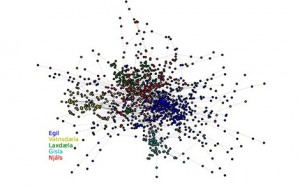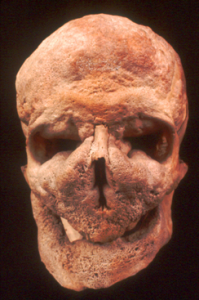
Between 800 and 1150 A.D., the word “Viking” would strike fear in the heart of any European. Originally from Scandinavia, the Vikings invaded much of medieval Europe, including Britain, France, and Germany. Their raids would come quickly and without warning, and simply the sight of the dragonhead prows on the Viking ships would make a seasoned warrior blanch.
History remembers the Vikings as ruthless raiders, “sea wolves,” and heathen savages. But violent history aside, scientists have also uncovered a complex society with a strong sense of community. New research conducted by Ralph Kenna and Padraig Mac Carron at Coventry University suggests that the Vikings formed social networks that resemble those of today. Kenna and Mac Carron achieved this by using statistical modeling to analyze ancient Viking texts ¬— proof of the oft-overlooked claim that science and the humanities do, at times, go hand in hand.

Kenna and Mac Carron analyzed eighteen stories from the Sagas of Icelanders, an epic about the Vikings settling Iceland around 1,000 years ago. This text was specifically chosen because it occurs in a relatively short period of time and contains a large number of characters, many of which appear in multiple sagas. The individual tales are diverse and rich in content. One, the Njáls saga, describes tribal feuds between 960 and 1020 A.D. Another, the Vatnsdaela saga, follows an individual named Ingimundur as he moves to Iceland with his family after hearing the prophecies of a fortune-teller.
From these eighteen stories, including the Njáls and Vatnsdaela sagas, Kenna and Mac Carron mapped out the travels of over 1,500 characters, keeping track of where the characters went and their meetings with other individuals — both friendly and hostile. Then they used this data to create web-like networks for each story, representing each character with a dot and connecting the dots of characters that had interacted with one another. With the help of these networks, Kenna and Mac Carron could visualize the social life of each character: They could see friends, enemies, friends of friends — even how often and where interactions took place. It was, in a nutshell, Facebook for Vikings.

While each saga had its own network, combining the five major saga networks — Egil, Vatnsdaela, Laxdaela, Gisla, and Njáls — revealed an astonishing degree of overlap. This indicated that characters were closely connected not only to their immediate friends and family, but also to those that appeared in other sagas, often through a network of mutual friends.
While analyzing all eighteen stories, the researchers noticed that one particular saga type did not have complex social networks: the outlaw saga. These tales are heavily focused on one individual, often someone who is forced to live in isolation. For instance, the Gisla saga describes an outlaw who is on the run for many years until finally being killed; not surprisingly, almost all the dots in the Gisla saga’s network are restricted to one area. But aside from the occasional exception, most stories — such as the Vatnsdaela and Laxdaela sagas — feature extensive, tightly intertwined networks. Kenna and Mac Carron call these family sagas.

Since its publication, the study has fallen under some scrutiny because the Sagas of Icelanders may not have been historically accurate. These are oral tales that could have been elaborated upon when written down. Luckily there are revealing clues that support their validity; in 1995, Scientific American published an article about the title character in the Egil saga, a Viking with a skull that resisted blows. This article showed that it was medically possible for Egil to exist, suggesting that all the sagas could be at least somewhat grounded in fact.
History, perhaps, has not been kind to the Vikings. People often remember them as savage invaders, but Kenna and Mac Carron’s findings serve as a reminder that Viking civilization was in fact highly developed, or at least developed enough to form complex social networks. Hopefully with more research to verify this study, history classes can begin presenting a more balanced depiction of the Vikings.
